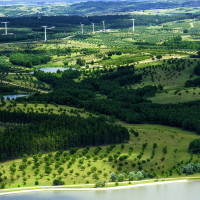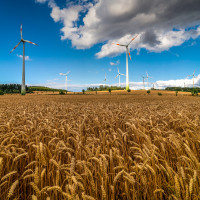Energy transition or energy expansion?
Topics
This report shows that neoliberal climate and energy policy has failed. It argues that the pursuit of endless growth and capitalist accumulation has resulted in an energy expansion, rather than an energy transition.

Downloads
Authors
Download the full report here.
Executive summary:
From politicians to corporate executives, media commentators to environmental campaigners, narratives evoking the “unstoppable” progress of a global transition from fossil fuels to renewable energy have grown increasingly commonplace.
However, in reality, the global shifts in energy production, energy usage and greenhouse gas emissions we urgently need are not happening:
- In 2019, over 80% of global primary energy demand came from fossil fuels, with global greenhouse gas emissions at record levels.
- In 2020, wind and solar accounted for just 10% of global electricity generated.
- Despite stories of its decline, coal-fired power generation continues to rise globally. In 2020, global efforts to decommission coal power plants were offset by the new coal plants commissioned in China alone, resulting in an overall increase in the global coal fleet of 12.5 GW.
Recently, some have argued that the Covid-19 pandemic and subsequent contraction in economic activity signal a turning point. Indeed, global energy demand fell by nearly 4% in 2020, while global energy-related CO2 emissions fell by 5.8% — the sharpest annual decline since the second world war.
Despite these short-term shifts, the pandemic has failed to result in any significant long-term changes for the energy sector or associated emissions:
- Global energy-related CO2 emissions are projected to grow by 4.8% in 2021, the second highest annual rise on record.
- Demand for all fossil fuels is set to rise in 2021.6 A 4.6% increase in global energy demand is forecast for 2021, leaving demand 0.5% higher than 2019 levels.
- By the end of 2020 electricity demand had already returned to a level higher than in December 2019, with global emissions from electricity higher than in 2015.
- By the end of 2020, global coal demand was 3.5% higher than in the same period in 2019. A 4.5% rise in coal demand is forecast for 2021, with coal demand increasing 60% more than all renewables growth combined and undoing 80% of the 2020 decline.
- Oil demand is forecast to rebound by 6% in 2021, the steepest rise since 1976. By 2026, global oil consumption is projected to reach 104.1 million barrels per day (mb/d), an increase of 4.4 mb/d from 2019 levels.
As such, an energy transition with the depth and speed necessary for meeting the 2015 Paris Agreement shows no sign of materializing. Indeed, most of the world’s major economies are not on track to reach their Nationally Determined Contributions (NDCs) on emissions reductions.
These facts point to a clear conclusion: the dominant, neoliberal climate policy paradigm, which deploys a “sticks and carrots” approach that attempts to disincentivize fossil fuels through carbon pricing, while promoting low-carbon investment through subsidies and preferential contractual arrangements has been completely ineffective. This policy paradigm positions governments as guardians and guarantors of the profitability of private actors, thus preventing them from addressing social or environmental challenges head-on. The results have been disastrous:
- 15 years after on the establishment of the European Union’s flagship Emissions Trading System, the vast majority of global emissions (84%) are still not priced at all, and the share of emissions that are priced high enough to be potentially effective remains well below 1%. The International Monetary Fund (IMF) estimates that the global average carbon price is a mere one-twentieth of the absolute minimum price it considers necessary.
- Although renewables have increased their global share of energy usage, this growth has been outstripped by rising electricity demand. The global electricity system has been expanding at an annual rate of nearly 300 GW per year in recent years, but renewable capacity only grew by 198 GW in 2020, and the rate of increase year-on-year has been slow over the past decade: an average of just 11 GW per year. Worse still, the rate of growth for renewable energy deployment has almost halved in the past five years.
Today the growth of renewables is being impeded by an investment crisis, and investment levels will need to increase dramatically in order to reach climate goals:
- China, responsible for 40% of renewables investment in 2017, reduced its renewables investment by 38% in 2018, with investments falling a further 8% in 2020 to the lowest figure since 2013.
- Investment in new renewable power generation capacity (mainly wind and solar) needs to total USD 22.5-trillion by 2050. That equates to around USD 662-billion each year, every year — roughly double the levels of investment seen in recent years, which have averaged around USD 300-billion.
Furthermore, the current policy does not adequately account for the im- pact of “variable renewable energy” (VRE):
- There is a risk that power utilities are increasingly unable to keep operating the “baseload” fossil fuel plants still relied upon across much of the world. As such, governments are currently stepping in to subsidize the fossil fuel industry, at the cost of the taxpayer or consumer.
- The technologies required to integrate renewable energy into electricity grids are themselves facing significant obstacles. For example, accord- ing to the IEA, under 2% of the global potential for demand-side flexibility is currently realized.
In sum, the current policy is incapable of delivering the energy transition urgently required. It relies on failed “market mechanisms” (“sticks and carrots”); suffers from a massive investment, deficit, and has failed to deal with the technical challenges posed by variable renewable energy.
We need an alternative paradigm. As we have seen with the pandemic, addressing complex global problems in short timescales calls for government planning and coordination. A TUED-PSI-FNME-CGT joint report on Public Energy Futures to be released at COP 26 will set out an agenda for democratically controlled public ownership and management of the energy sector. A truly public approach to energy transition is necessary for limiting climate change and avoiding the worst climate impacts.



